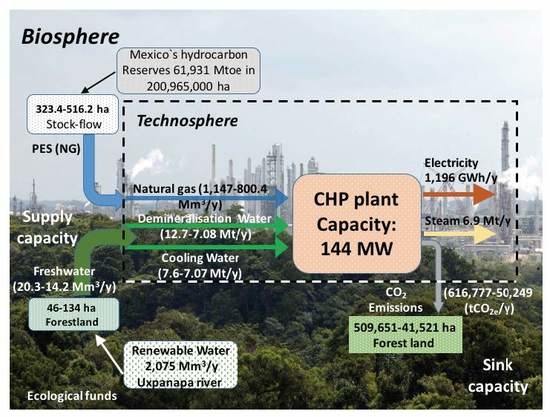An Integrated Approach to Determining the Capacity of Ecosystems to Supply Ecosystem Services into Life Cycle Assessment for a Carbon Capture System
Abstract
Featured Application
Abstract
1. Introduction
- (i)
- The scope of the definition of the FU, which refers to a quantitative description of the function or service, and which is the basis for determining the reference flow of process or PS, is very short (e.g., hours, minutes, or seconds) [37,38,39,40]. Thus, LCA only considers one scale (micro-temporal) and one dimension (technological) at a time.
- (ii)
- The life cycle inventory (LCI) provides different flows (material, energy, resources) that have been handled as individual or isolated numbers without considering that they may come from a limited source of resources. A key distinguishing feature of the LCA is that the mathematical protocol developed for measuring the elementary flows—materials and energy—is steady-state-based and uses a top-down causality model [35] rather than a constant flow rate (mass per unit time) [41]. Additionally, LCA accounts for flows but not natural infrastructure or ecological funds (EFs) that means that the inflows (LCI) and outflows (products and potential environmental impacts) of LCA do not take into account the EF´s availability (soil, aquatic, and terrestrial ecosystems, atmosphere, and ecological resources) to assess the PS [42]. This means that LCA does not consider reciprocal relationships between the EFs and their flows, i.e., its nexus.
- (iii)
2. Materials and Methods
2.1. Introduction to the Principles of MuSIASEM
2.2. MuSIASEM Principles in LCA
2.3. LCA Case Study: CHP w/o and wPCC Plus FCS
2.4. Requirement of Flow-Ecological Funds (Water and PES)
2.5. Requirement of Sink Capacity (Size and Quality of the Ecological Fund to CO2 Emissions)
3. Results and Discussion
3.1. Spatiotemporal to One-Year Operations
3.2. External Constraints: Depletion of Abiotic and Biotic Natural Resources
3.3. Sink Capacity: Modelling CO2 Emissions and FCS
3.4. The Usefulness of the WEC Nexus as a Flow–Fund Ratio and Fund Size in LCA
4. Conclusions
Author Contributions
Funding
Acknowledgments
Conflicts of Interest
Abbreviations
| BECCS | Biomass energy with carbon capture and storage |
| CC | Climate change |
| CCUS | CO2 capture, use and sequestration |
| CHP | Combined heat and power |
| CHP wPCC | Combined heat and power with post-combustion carbon capture |
| EWFLE | Ecosystem–water–food–land–energy |
| EFs | Ecological funds |
| FEED | Front end engineering design |
| FU | Functional Unit |
| FF | Flow-Fund |
| FF-LCA | Flow-Fund-Life Cycle Assessment |
| FCS | Forest carbon sequestration |
| GT | Gas turbine |
| GIS | Geographic information system |
| GWh | Gigawatts per hour |
| HRSG | Heat recovery steam generator |
| JaP | Jaguaroundi Park |
| LCA | Life cycle assessment |
| LCI | Life cycle inventory |
| LCIA | Life cycle impact assessment |
| MWh | Megawatts per hour |
| MuSIASEM | Multi-Scale Integrated Assessment of Society and Ecosystem Metabolism |
| NG | Natural gas |
| PEMEX | Petróleos Mexicanos (Mexican O&G industry) |
| PES | Primary energy source |
| PCC | Post-combustion carbon capture |
| PS | Product system |
| ST | Steam turbine |
| SES | Socio-ecological systems |
| TES-LCA | Techno-ecological synergy-LCA |
| TzP | Tuzandepelt Park |
| WEC | Water–energy–carbon |
References
- Motazedi, K.; Abella, J.P.; Bergerso, J.A. Techno-Economic Evaluation of Technologies to Mitigate Greenhouse Gas Emissions at North American Refineries. Environ. Sci. Technol. 2017, 51, 1918–1928. [Google Scholar] [CrossRef]
- Mexico’s Ministry of Energy (SENER). Programa de Desarrollo del Sector Eléctrico Nacional 2019–2033. Gobierno de México. 2018. Available online: https://www.gob.mx/sener/documentos/prodesen-2019-2033 (accessed on 30 July 2019). (In Spanish).
- Morales-Mora, M.A.; Pretelín Vergara, C.; Martínez-Delgadillo, S.A.; Iuga, C.; Nolasco-Hipólito, C. Environmental assessment of a combined heat and power (CHP) plant configuration proposal with post-combustion CO2 capture for the Mexican oil and gas industry. Clean Technol. Environ. Policy 2019, 21, 213–226. [Google Scholar] [CrossRef]
- Mekonnen, M.M.; Hoekstra, A.Y. Four billion people facing severe water scarcity. Sci. Adv. 2016, 2, e1500323. [Google Scholar] [CrossRef]
- Escalante-Sandoval, C.; Nuñez-Garcia, P. Meteorological drought features in northern and northwestern parts of Mexico under different climate change scenarios. J. Arid Land 2017, 9, 65–75. [Google Scholar] [CrossRef]
- Giampietro, M.; Aspinall, R.J.; Bukkens, S.G.F.; Benalcazar, J.C.; Diaz-Maurin, F.; Flammini, A.; Tiziano Gomiero, T.; Zora Kovacic, Z.; Madrid, C.; Ramos-Martín, J.; et al. An Innovative Accounting Framework for the Food-Energy-Water Nexus—Application of the MuSIASEM Approach to Three Case Studies; Environment and Natural Resources; Working Paper No.56; Food and Agriculture Organization: Rome, Italy, 2013. [Google Scholar]
- Endo, A.; Tsurita, I.; Burnett, K.; Orencio, P.M. A review of the current state of research on the water, energy, and food nexus. J. Hydrol. Reg. Stud. 2017, 11, 20–30. [Google Scholar] [CrossRef]
- Liu, Y.; Chen, W.Q.; Lin, T.; Gao, L. How Spatial Analysis Can Help Enhance Material Stocks and Flows Analysis? Resources 2019, 8, 46. [Google Scholar] [CrossRef]
- Giampietro, M.; Saltelli, A. Footprint to nowhere. Ecol. Indic. 2014, 46, 610–621. [Google Scholar] [CrossRef]
- Galli, A.; Giampietro, M.; Goldfingerd, S.; Lazarusd, E.; Lind, D.; Saltellie, A.; Wackernageld, M.; Müllerf, F. Questioning the Ecological Footprint. Ecol. Indic. 2016, 69, 224–232. [Google Scholar] [CrossRef]
- FAO. The Water-Energy-Food Nexus. A New Approach in Support of Food Security and Sustainable Agricultura. 2014. Available online: http://www.fao.org/3/a-bl496e.pdf (accessed on 22 May 2019).
- United Nations World Water Assessment Programme/UN-Water (WWAP). The United Nations World Water Development Report 2018: Nature-Based Solutions for Water; UNESCO: Paris, France, 2018; Available online: https://reliefweb.int/sites/reliefweb.int/files/resources/261424e.pdf (accessed on 13 June 2019).
- The Nature Conservancy (TNC). Beyond the Source: The Environmental, Economic and Community Benefits of Source Water Protection; The Nature Conservancy: Arlington, VA, USA, 2017; Available online: https://www.nature.org/content/dam/tnc/nature/en/documents/Beyond_The_Source_Full_Report_FinalV4.pdf (accessed on 10 May 2019).
- Georgescu-Roegen, N. The Entropy Law and the Economic Process; Harvard University Press: Cambridge, MA, USA, 1971. [Google Scholar]
- Giampietro, M. On the Circular Bioeconomy and Decoupling: Implications for Sustainable Growth. Ecol. Econ. 2019, 162, 143–156. [Google Scholar] [CrossRef]
- Lomas, P.L.; Giampietro, M. Environmental accounting for ecosystem conservation: Linking societal and ecosystem metabolisms. Ecol. Model. 2017, 346, 10–19. [Google Scholar] [CrossRef]
- International Energy Agency. Energy Policies beyond IEA Countries—Mexico 2017. Available online: https://webstore.iea.org/energy-policies-beyond-iea-countries-mexico-2017 (accessed on 20 July 2019).
- Rodríguez-Martínez, A.; Lechón, Y.; Cabal, H.; Castrejón, D.; Flores, M.P.; Romero, R.J. Consequences of the National Energy Strategy in the Mexican Energy System: Analyzing Strategic Indicators with an Optimization Energy Model. Energies 2018, 11, 2837. [Google Scholar] [CrossRef]
- Petroleos Mexicanos. Pemex’s Business Plant 2019–2023. Gobierno de Mexico. 2019. Available online: https://www.pemex.com/en/press_room/press_releases/Paginas/2019-034-national.aspx (accessed on 20 July 2019).
- IEA. Energy Policies beyond IEA Countries-Mexico 2017. Available online: https://webstore.iea.org/energy-policies-beyond-iea-countries-mexico-2017 (accessed on 18 June 2019).
- IPCC. Climate Change 2014: Mitigation of Climate Change. Working Group II Contribution to the IPCC 5th Assessment Report Changes to the Underlying Scientific/Technical Assessment, 101p. Available online: https://www.ipcc.ch/report/ar5/syr/ (accessed on 5 May 2019).
- Global CCS Institute. The Global Status of CCS Report 2018. Available online: https://www.globalccsinstitute.com/ (accessed on 18 June 2019).
- Hassiba, R.J.; Al-Mohannadi, D.M.; Linke, P. Carbon dioxide and heat integration of industrial parks. J Clean Prod. 2017, 155, 47–56. [Google Scholar] [CrossRef]
- Wang, M.; Oko, E. Special issue on carbon capture in the context of carbon capture, utilisation and storage (CCUS). Int. J. Coal Sci. Technol. 2017, 4, 1–4. [Google Scholar] [CrossRef]
- Rubin, E.S.; Davison, J.E.; Herzog, H.J. The cost of CO2 capture and storage. Int. J. Greenh. Gas Control 2015, 40, 378–400. [Google Scholar] [CrossRef]
- MacDowell, N.; Fennell, P.S.; Shah, N.; Maitland, G.C. The role of CO2 capture and utilization in mitigating climate change. Nat. Clim. Chang. 2017, 7, 243–249. [Google Scholar] [CrossRef]
- Armstrong, K.; Styring, P. Assessing the potential of utilization and storage strategies for post-combustion CO2 emissions reductions. Front. Energy Res. 2015, 3, 8. [Google Scholar] [CrossRef]
- Li, J.; Hou, Y.; Wang, P.; Yang, B.A. Review of Carbon Capture and Storage Project Investment and Operational Decision-Making Based on Bibliometrics. Energies 2019, 12, 23. [Google Scholar] [CrossRef]
- Dai, J.; Wu, S.; Han, G.; Weinberg, J.; Xie, X.; Wu, X.; Song, X.; Jia, B.; Xue, W.; Yang, Q. Water-energy nexus: A review of methods and tools for macro-assessment. Appl. Energy 2018, 210, 393–408. [Google Scholar] [CrossRef]
- Giampietro, M.; Mayumi, K.; Rámos-Martín, J. Multi-scale integrated analysis of societal and ecosystem metabolism (MuSIASEM): Theoretical concepts and basic rationale. Energy 2009, 34, 313–322. [Google Scholar] [CrossRef]
- Mannan, M.; Al-Ansari, T.; Mackey, H.R.; Al-Ghamdi, S.G. Quantifying the energy, water and food nexus: A review of the latest developments based on life-cycle assessment. J. Clean. Prod. 2018, 193, 300–314. [Google Scholar] [CrossRef]
- Karabulut, A.A.; Eleonora Crenna, E.; Sala, S.; Udias, A. A proposal for integration of the ecosystem-water-food-land-energy (EWFLE) nexus concept into life cycle assessment: A synthesis matrix system for food security. J. Clean. Prod. 2018, 172, 3874–3889. [Google Scholar] [CrossRef]
- Liu, X.; Bakshi, B.R. Ecosystem Services in Life Cycle Assessment while Encouraging Techno-Ecological Synergies. J. Ind. Ecol. 2018, 23, 2. [Google Scholar] [CrossRef]
- Moltesen, A.; Bjørn, A. LCA and Sustainability. In Life Cycle Assessment: Theory and Practice; Hauschild, M.Z., Rosenbaum, R.K., Olsen, S.I., Eds.; Springer: Berlin, Germany, 2018; pp. 59–66. [Google Scholar] [CrossRef]
- Hellweg, S.; i Canals, L.M. Emerging approaches, challenges and opportunities in life cycle assessment. Science 2014, 344, 1109–1113. [Google Scholar] [CrossRef] [PubMed]
- Bjørn, A.; Owsianiak, M.; Laurent, A.; Olsen, S.I.; Corona, A.; Hauschild, M.Z. Scope Definition. In Life Cycle Assessment: Theory and Practice; Hauschild, M.Z., Rosenbaum, R.K., Olsen, S.I., Eds.; Springer: Berlin, Germany, 2018; pp. 75–116. [Google Scholar] [CrossRef]
- ISO 14040. Environmental Management—Life Cycle Assessment—Principles and Framework, 2nd ed.; ISO: Geneva, Switzerland, 2006. [Google Scholar]
- Dyckhoff, H.; Kasah, T. Time Horizon and Dominance in Dynamic Life Cycle Assessment. J. Ind. Ecol. 2014, 18, 799–808. [Google Scholar] [CrossRef]
- Hauschild, M.Z. Introduction to LCA Methodology. In Life Cycle Assessment: Theory and Practice; Hauschild, M.Z., Rosenbaum, R.K., Olsen, S.I., Eds.; Springer: Berlin, Germany, 2018; pp. 75–116. [Google Scholar]
- de Haes, H.A. Life-Cycle Assessment and the Use of Broad Indicators. J. Ind. Ecol. 2006, 10, 5–7. [Google Scholar] [CrossRef]
- Ryberg, M.W.; Owsianiaka, M.; Richardsonb, K.; Hauschild, M.Z. Development of a life-cycle impact assessment methodology linked to the Planetary Boundaries framework. Ecol. Indic. 2018, 88, 250–262. [Google Scholar] [CrossRef]
- Yang, Y.; Zheng, H.; Kong, L.; Huang, B.; Xu, W.; Ouyang, Z. Mapping ecosystem services bundles to detect high- and low-value ecosystem services areas for land use management. J. Clean. Prod. 2019, 225, 11–17. [Google Scholar] [CrossRef]
- Maier, M.; Mueller, M.; Yan, X. Introducing a localised spatio-temporal LCI method with wheat production as exploratory case study. J. Clean. Prod. 2017, 140, 492–501. [Google Scholar] [CrossRef]
- Pavan, A.L.R.; Ometto, A.R. Ecosystem Services in Life Cycle Assessment: A novel conceptual framework for soil. Sci. Total Environ. 2018, 643, 1337–1347. [Google Scholar] [CrossRef]
- Rosen, R. Life Itself: A Comprehensive Inquiry into the Nature, Origin, and Fabrication of Life; Columbia University Press: New York, NY, USA, 1991. [Google Scholar]
- Giampietro, M. Perception and Representation of the Resource Nexus at the Interface between Society and the Natural Environment. Sustainability 2018, 10, 2545. [Google Scholar] [CrossRef]
- Madrid-López, C.; Giampietro, M. The Water Metabolism of Socio-Ecological Systems. Reflections and a Conceptual Framework. J. Ind. Ecol. 2015, 19, 5. [Google Scholar] [CrossRef]
- Mayumi, K.; Giampietro, M. Proposing a general energy accounting scheme with indicators for responsible development: Beyond monism. Ecol. Indic. 2014, 47, 50–66. [Google Scholar] [CrossRef]
- Masera, R.O.; Garza-Caligaris, J.F.; Kanninen, M.; Karjalainen, T.; Liski, J.; Nabuurs, G.J.; Pussinen, A.; de Jong, B.H.J.; Mohren, G.M.J. Modeling carbon sequestration in afforestation, agroforestry and forest management projects: The CO2FIX V.2 approach. Ecol. Model. 2003, 164, 177–199. [Google Scholar] [CrossRef]
- Mancini, M.S.; Galli, A.; Niccolucci, V.; Lin, D.; Bastianoni, S.; Wackernagel, M.; Nadia Marchettini, N. Ecological Footprint: Refining the carbon Footprint calculation. Ecol. Indic. 2016, 61, 390–403. [Google Scholar] [CrossRef]
- De Haes, H.U.; Finnveden, G.; Goedkoop, M.; Hertwich, E.; Hofstetter, P.; Klöpffer, W.; Krewitt, W.; Lindeijer, E. Life-Cycle Impact Assessment: Striving towards Best Practice; SETAC Press: Pensacola, FL, USA, 2002. [Google Scholar]
- Urban, P.; Sabo, P.; Jan Plesník, J. Non-equilibrium thermodynamics and development cycles of temperate natural forest ecosystems. Folia Oecol. 2018, 45, 61–71. [Google Scholar] [CrossRef]
- Diario Oficial de la Federación (DOF). Acuerdo por el que se dan a Conocer los Resultados del Estudio Técnico de las Aguas Nacionales Superficiales en las Cuencas Hidrológicas Alto Río Coatzacoalcos, Bajo Río Coatzacoalcos, Alto Río Uxpanapa, Bajo Río Uxpanapa, Río Huazuntlán y Llanuras de Coatzacoalcos, Pertenecientes a la Subregión Hidrológica Coatzacoalcos de la Región Hidrológica Número 29 Coatzacoalcos. Comisión Nacional del Agua. Diario Oficial de la Federación. 2017. Available online: http://biblioteca.semarnat.gob.mx/janium/Documentos/Ciga/agenda/DOFsr/DO4214.pdf (accessed on 29 May 2019).
- Diario Oficial de la Federación (DOF). Acuerdo por el que se Actualiza la Disponibilidad Media Anual de las Aguas Nacionales Superficiales de las 757 Cuencas Hidrológicas que Comprenden las 37 Regiones Hidrológicas en que se Encuentra Dividido los Estados Unidos Mexicanos. Diario Oficial de la Federación de la Federación. 2016. Available online: http://dof.gob.mx/nota_detalle.php?codigo=5443858&fecha=07/07/2016 (accessed on 28 May 2019).
- Diario Oficial de la Federación (DOF). Acuerdo por el que se Actualiza la Disponibilidad Media Anual de Agua Subterránea de los 653 Acuíferos de los Estados Unidos Mexicanos. Diario Oficial de la Federación DOF. 2018. Available online: http://www.dof.gob.mx/nota_detalle.php?codigo=5510042&fecha=04/01/2018 (accessed on 28 May 2019).
- Gleick, P.H.; Palaniappan, M. Peak water limits to freshwater withdrawal and use. Proc. Natl. Acad. Sci. USA 2010, 107, 11155–11162. [Google Scholar] [CrossRef]
- CONAGUA. Estadísticas del Agua en México, Edición 2018. Secretaria de Medio Ambiente y Recursos Naturales, Comisión Nacional del Agua. 2018. Available online: http://sina.conagua.gob.mx/publicaciones/EAM_2018.pdf (accessed on 10 April 2019).
- PEMEX-NHC. Reservas de Hidrocarburos en México: Conceptos Fundamentales y Análisis. 2018. Available online: https://www.gob.mx/cms/uploads/attachment/file/435679/20190207._CNH-_Reservas-2018._vf._V7.pdf (accessed on 22 April 2019).
- INEGI-NHC. Digital Map of Mexico: Exploration and Extraction of Hydrocarbons. 2019. Available online: http://gaia.inegi.org.mx/mdm6/?v=bGF0OjIzLjMyMDA4LGxvbjotMTAxLjUwMDAwLHo6MSxsOmMxMTFzZXJ2aWNpb3M= (accessed on 25 May 2019).
- Hiloidhari, M.; Baruah, D.C.; Singh, A.; Kataki, S.; Medhi, K.; Kumari, S.; Ramachandra, T.V.; Jenkins, B.M.; Thakur, I.S. Emerging role of Geographical Information System (GIS), Life Cycle Assessment (LCA) and spatial LCA (GIS-LCA) in sustainable bioenergy planning. Bioresour. Technol. 2017, 242, 218–226. [Google Scholar] [CrossRef]
- Martínez-Bravo, R.; Masera, O. La captura de carbono como servicio ecosistémico del Parque Ecológico Jaguaroundi: Una estrategia ara la conservación y manejo de los recursos forestales. In Yolanda Nava e Irma Roja (Coords); El Parque Ecológico Jaguaroundi; Conservación de la Selva Tropical Veracruzana en una Zona Industrializada; PUMA-UNAM: Mexico City, Mexico, 2008; pp. 103–114. [Google Scholar]
- Martínez-Bravo, R.; Masera, O. Estimación de la línea base de carbono (Estudios técnicos para definir el desarrollo y funcionamiento del Parque Ecológico Tuzandepetl, Partida No. 8). In Para Petróleos Mexicanos Exploración y Producción (Villahermosa, México); Informe Técnico de la Universidad Nacional Autónoma de México Centro de Investigaciones en Ecosistemas: Morelia, Mexico, 2012. [Google Scholar]
- Kim, H.; Kim, Y.H.; Kim, R.; Park, H. Reviews of forest carbon dynamics models that use empirical yield curves: CBM-CFS3, CO2FIX, CASMOFOR, EFISCEN. For. Sci. Technol. 2015, 11, 212–222. [Google Scholar] [CrossRef]
- Nava, Y.; Rojas, I. El Parque Ecológico Jaguaroundi Conservación de la Selva Tropical Veracruzana en una Zona Industrializada (Coordinadoras); Programa Universitario de Medio Ambiente Universidad Nacional Autónoma de México Secretaría de Medio Ambiente y Recursos Naturales Instituto Nacional de Ecología Petróleos Mexicanos-Petroquímica: Mexico City, Mexico, 2008. [Google Scholar]
- Álvarez-García, H.; Batalla-González, E.; del Olmo, G.; Cruz-Silva, A.; Naranjo-García, E.; Espinosa-Pérez, H.; Ricker, M. Estudios Técnicos para Definir el Desarrollo y Funcionamiento del Parque Ecológico Tuzandepetl; Tercer Informe General; Partida No. 1 Diagnóstico de Flora y Fauna, Parte 2; Instituto de Biología de la Universidad Nacional Autónoma de México, PEMEX-Exploración y Producción: Mexico City, Mexico, 2012. [Google Scholar]
- Turner, P.A.; Mach, K.J.; Lobell, D.B.; Benson, S.M.; Baik, E.; Sanchez, D.L.; Field, C.B. The global overlap of bioenergy and carbon sequestration potential. Clim. Chang. 2018, 148, 1–10. [Google Scholar] [CrossRef]
- ISO. ISO 14046—Environmental Management—Water Footprint—A Practical Guide for SMEs; ISO: Geneva, Switzerland, 2014. [Google Scholar]
- Sorman, A.H.; Giampietro, M. The energetic metabolism of societies and the degrowth paradigm: Analyzing biophysical constraints and realities. J. Clean. Prod. 2013, 38, 80–93. [Google Scholar] [CrossRef]
- National Hydrocarbons Commission (NHC). Hydrocarbons Maps. 2019. Available online: https://mapa.hidrocarburos.gob.mx/ (accessed on 22 June 2019).
- Pompa-García, M.; Cigala-Rodríguez, J.A. Variation of carbón uptake from forest species in Mexico: A review. Madera Bosques 2017, 23, 225–235. [Google Scholar] [CrossRef][Green Version]
- Holling, C.S. Understanding the complexity of economic, ecological and social systems. Ecosystems 2001, 4, 390–405. [Google Scholar] [CrossRef]
- Fridahl, M.; Mariliis Lehtveer, M. Bioenergy with carbon capture and storage (BECCS): Global potential, investment preferences, and deployment barriers. Energy Res. Soc. Sci. 2018, 42, 155–165. [Google Scholar] [CrossRef]
- Global CCS Institute. Financing BECCS in Developing Countries. 2019. Available online: https://www.globalccsinstitute.com/resources/publications-reports-research/financing-beccs-in-developing-countries/ (accessed on 1 June 2019).
- Gough, C.; Garcia-Freites, S.; Jones, C.; Mander, S.; Moore, B.; Pereira, C.; Röder, M.; Vaughan, N.; Welfle, A. Challenges to the use of BECCS as a keystone technology in pursuit of 1.5 °C. Glob. Sustain. 2018, 1. [Google Scholar] [CrossRef]
- Gomiero, T. Are Biofuels an Effective and Viable Energy Strategy for Industrialized Societies? A Reasoned Overview of Potentials and Limits. Sustainability 2015, 7, 8491–8521. [Google Scholar] [CrossRef]
- IPCC. Global Warming of 1.5 °C. In Proceedings of the First Joint Session of Working Groups I, II and III of the IPCC and Accepted by the 48th Session of the IPCC, WMO-UNEP, Incheon, Korea, 6 October 2018; Available online: http://www.ipcc.ch/report/sr15/ (accessed on 13 May 2019).
- Keith, D.W.; Holmes, G.; Angelo, D.S.; Heidel, K. A Process for Capturing CO2 from the Atmosphere. Joule 2018, 2, 1573–1594. [Google Scholar] [CrossRef]
- Busch, J.; Engelmann, J.; Cook-Patton, S.C.; Griscom, B.W.; Kroeger, T.; Possingham, H.; Shyamsundar, P. Potential for Low-Cost Carbon Dioxide Removal through Tropical Reforestation. Nat. Clim. Chang. 2019, 9, 463–466. [Google Scholar] [CrossRef]
- Garcia, C.A.; García-Trevino, E.S.; Aguilar-Rivera, N.; Armendariz, C. Carbon footprint of sugar production in Mexico. J. Clean. Prod. 2015, 112, 2632–2641. [Google Scholar] [CrossRef]
- Mexican Government. Intended Nationally Determined Contribution 2015. Available online: https://www.gob.mx/cms/uploads/attachment/file/162973/2015_indc_ing.pdf (accessed on 28 May 2019).
- Meza-Palacios, R.; Aguilar-Lasserre, A.A.; Morales-Mendoza, L.F.; Pérez-Gallardo, J.R.; Rico-Contreras, J.O.; Avarado, L. The environmental contribution to human health, climate change, ecosystem quality and resources in México. J. Environ. Sci. Health 2019, 54, 668–678. [Google Scholar] [CrossRef]
- IPCC-SRCCL. Clime Change and Land. 2019. Available online: https://www.ipcc.ch/report/srccl/ (accessed on 23 August 2019).
- Smil, V. Power Density: A key to Understanding Energy Resources and Uses; The MIT Press: Cambridge, MA, USA, 2015. [Google Scholar]
- Días-Maurin, F.; Giampietro, M. A “Grammar” for assessing the performance of power-supply systems: Comparing nuclear energy to fossil energy. Energy 2013, 49, 162–177. [Google Scholar] [CrossRef]
- Liu, X.; Ziv, G.; Bakshi, B.R. Ecosystem services in life cycle assessment—Part 1: A computational framework. J. Clean. Prod. 2018, 197, 314–322. [Google Scholar] [CrossRef]
- Othoniel, B.; Rugani, B.; Heijungs, R.; Enrico Benetto, E.; Withagen, C. Assessment of Life Cycle Impacts on Ecosystem Services: Promise, Problems, and Prospects. Environ. Sci. Technol. 2016, 50, 1077–1092. [Google Scholar] [CrossRef] [PubMed]
- Tang, L.; Hayashi, K.; Kohyama, K.; Leon, A. Reconciling Life Cycle Environmental Impacts with Ecosystem Services: A Management Perspective on Agricultural Land Use. Sustainability 2018, 10, 630. [Google Scholar] [CrossRef]
- Sohna, J.; Croxatto Vegaa, G.; Morten Birkveda, M. A Methodology Concept for Territorial Metabolism—Life Cycle Assessment: Challenges and Opportunities in Scaling from Urban to Territorial Assessment. Procedia CIRP 2018, 69, 89–93. [Google Scholar] [CrossRef]
- Escrig-Olmedo, E.; Fernández-Izquierdo, M.A.; Ferrero-Ferrero, I.; Rivera-Lirio, J.M.; Muñoz-Torres, M.J. Rating the Raters: Evaluating how ESG Rating Agencies Integrate Sustainability Principles. Sustainability 2019, 11, 915. Available online: https://www.mdpi.com/2071-1050/11/3/915/pdf-vor (accessed on 30 April 2019). [CrossRef]
- S&P Global Ratings How Does S&P Global Ratings Incorporate Environmental, Social, and Governance Risks into Its Ratings Analysis. 2017. Available online: https://www.spratings.com/documents/20184/1634005/How+does+sandp+incorporate+ESG+Risks+into+its+ratings/6a0a08e2-d0b2-443b-bb1a-e54b354ac6a5 (accessed on 26 June 2019).
- United Nations Framework Convention on Climate Change (UNFCCC). Interim NDC Registry. 2019. Available online: https://www4.unfccc.int/sites/NDCStaging/Pages/All.aspx (accessed on 15 June 2019).
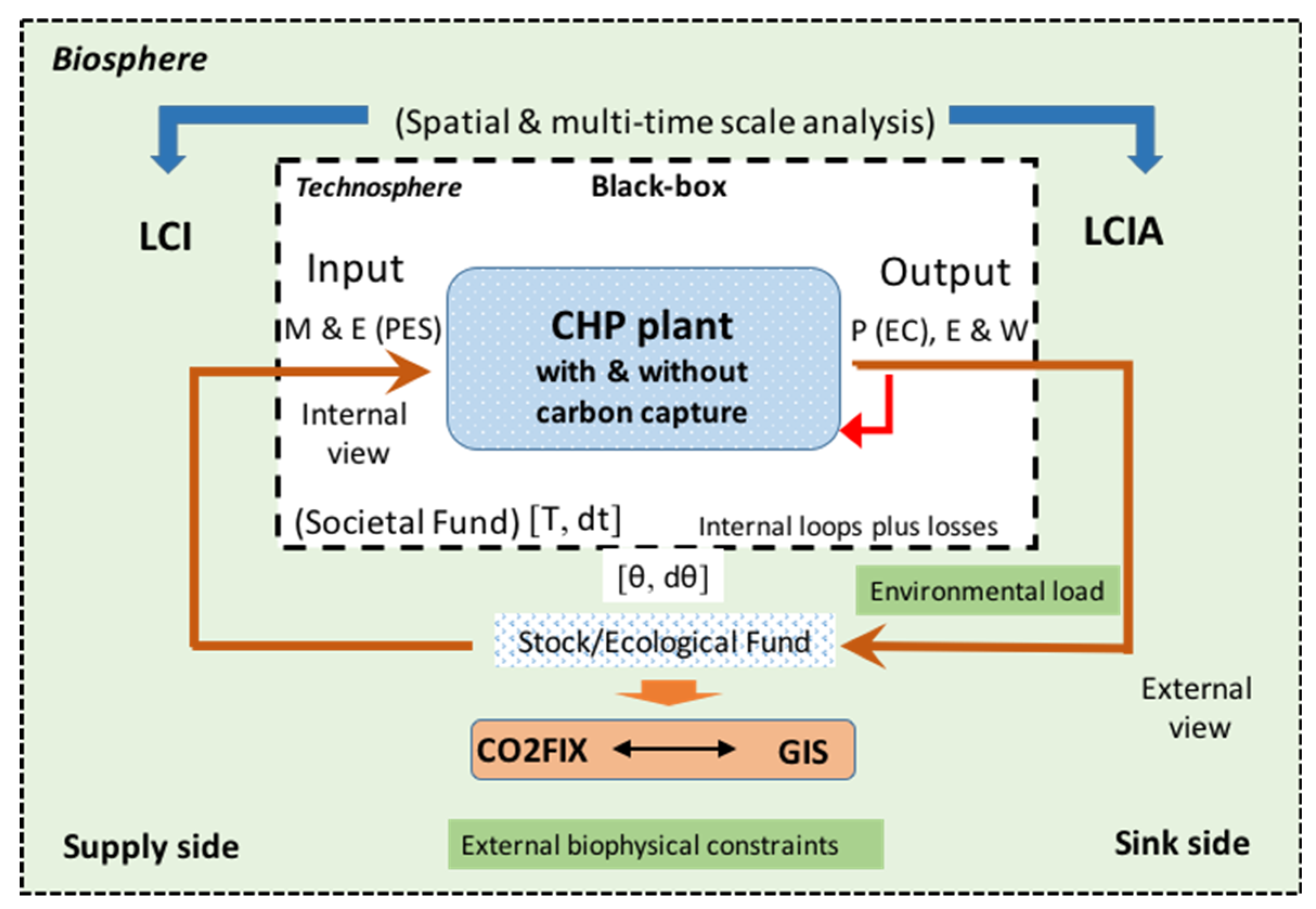
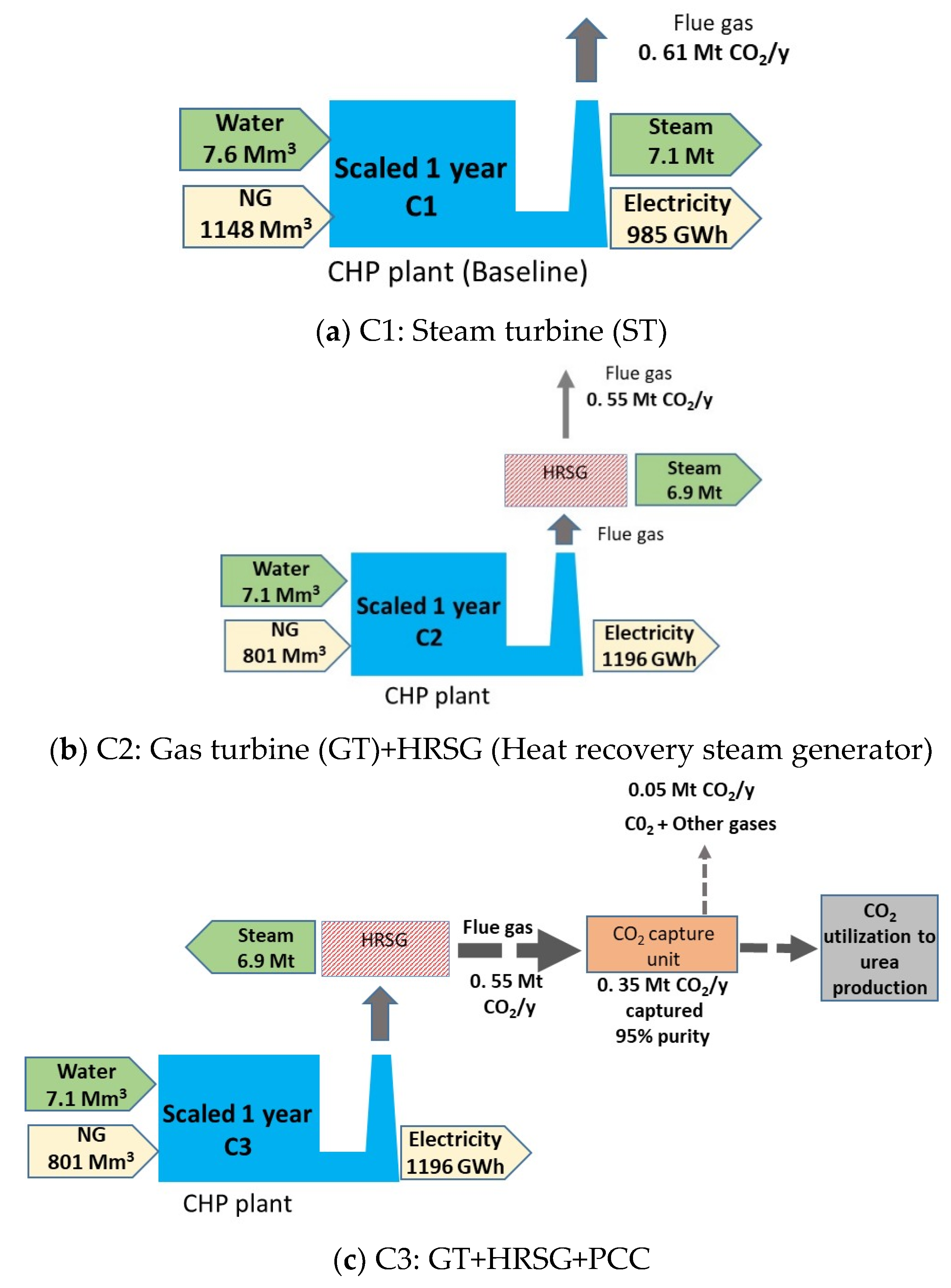
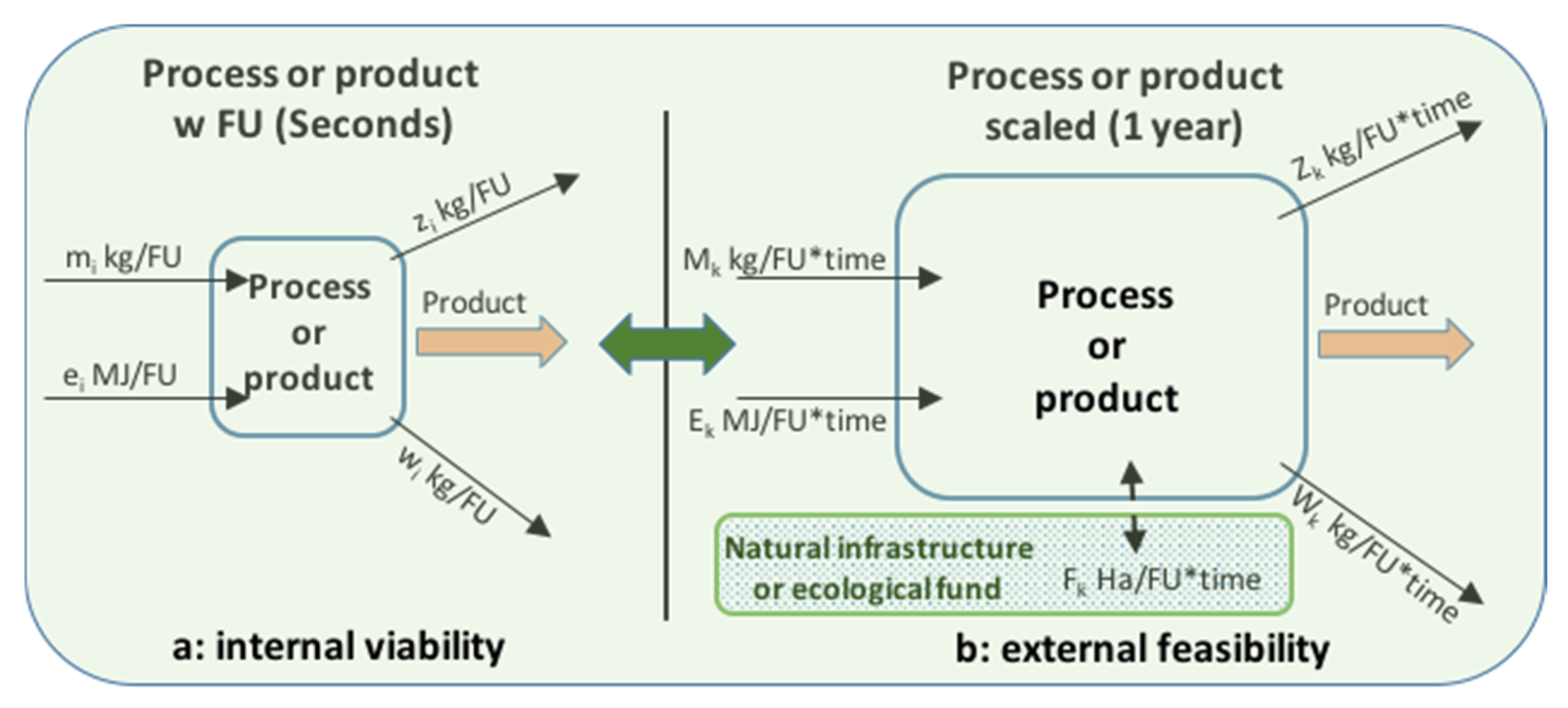
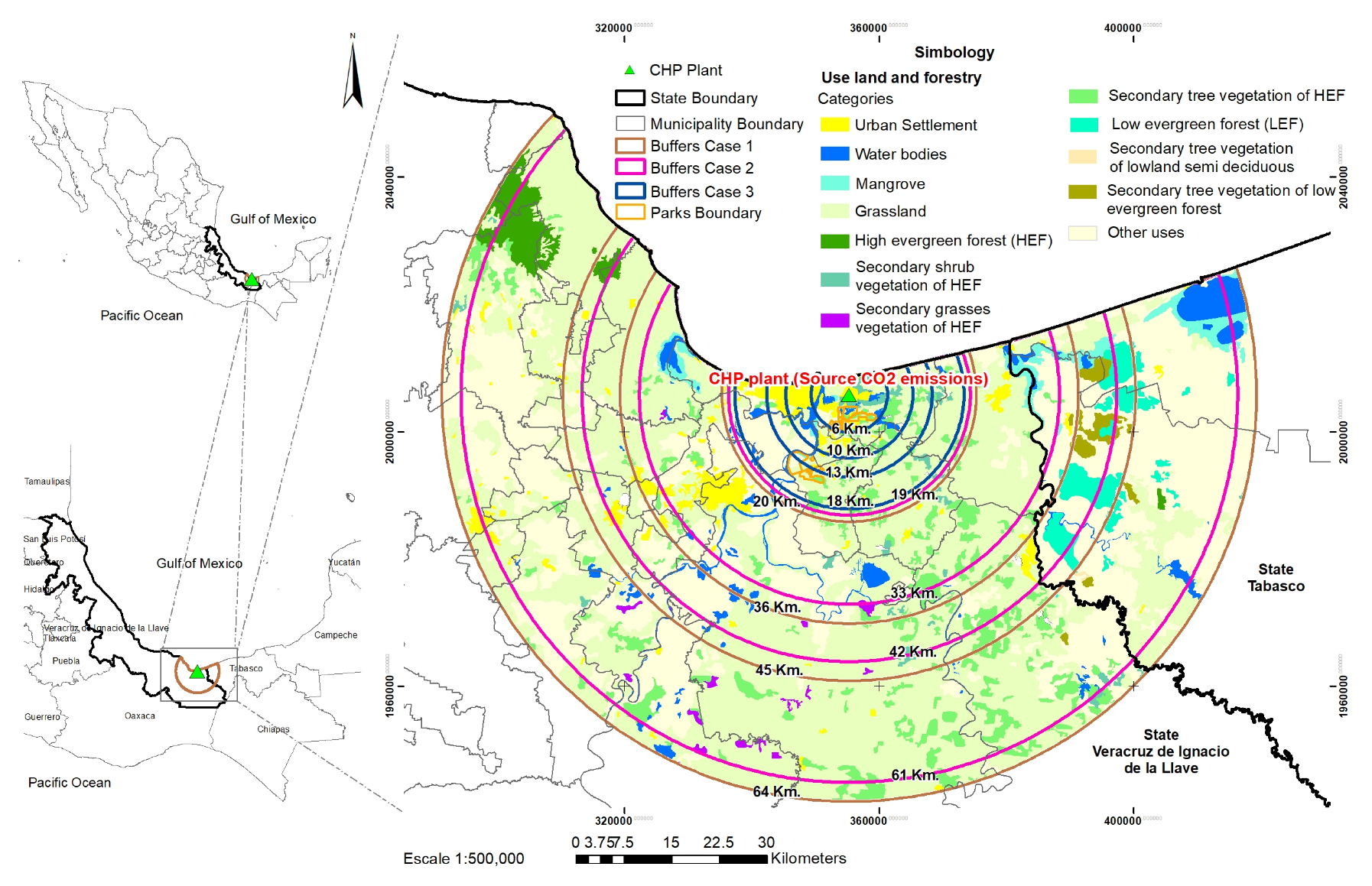
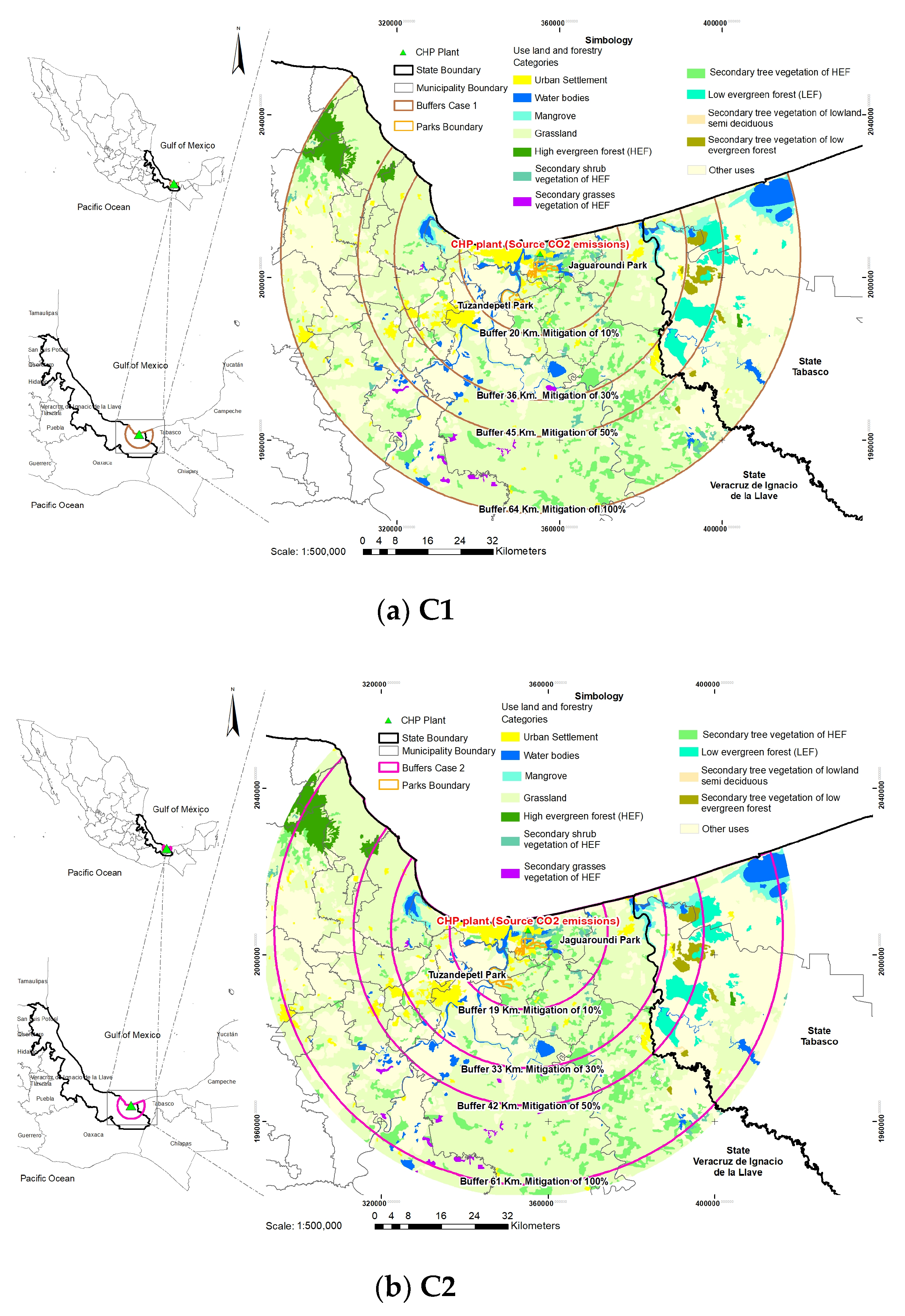
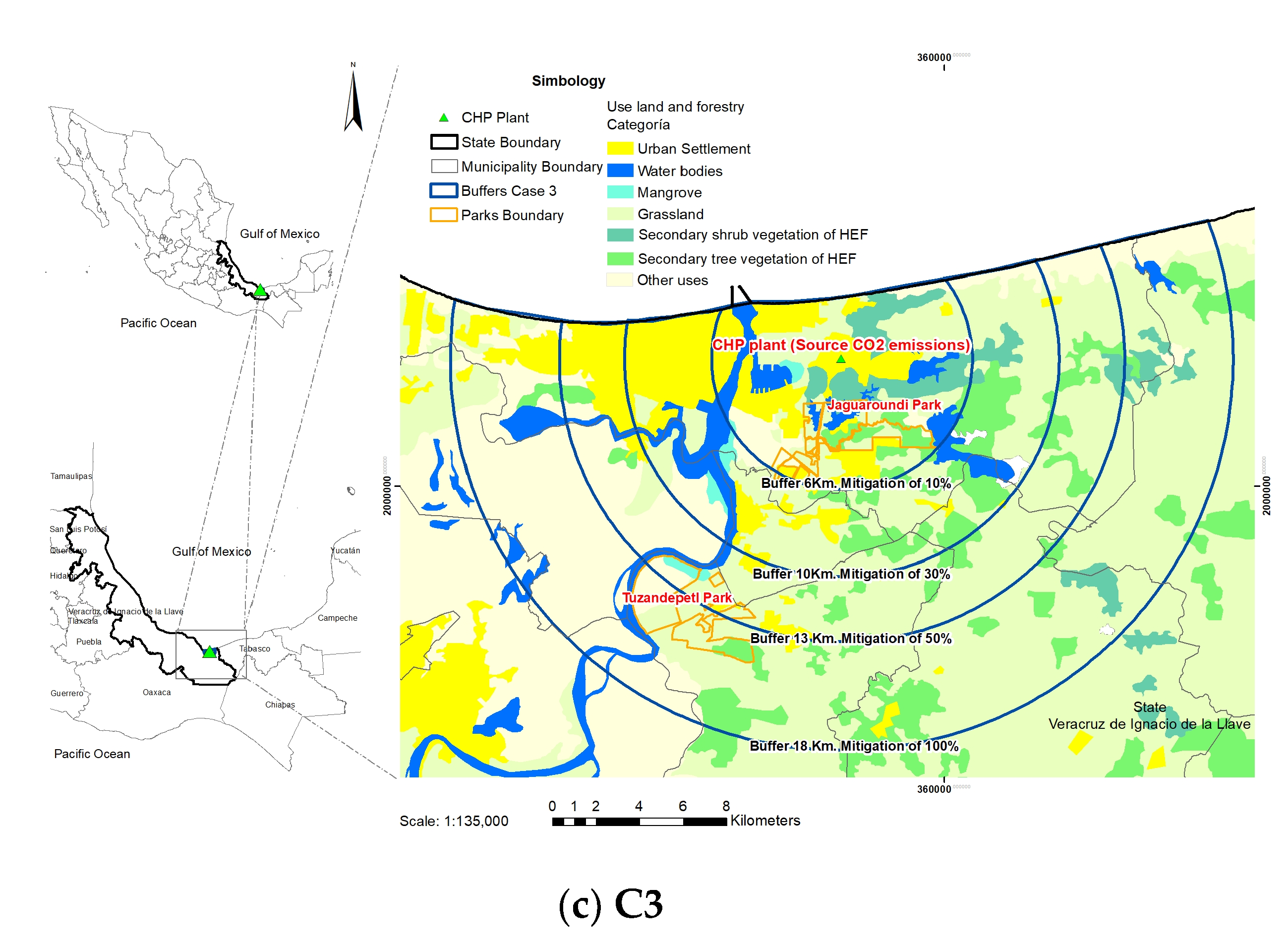
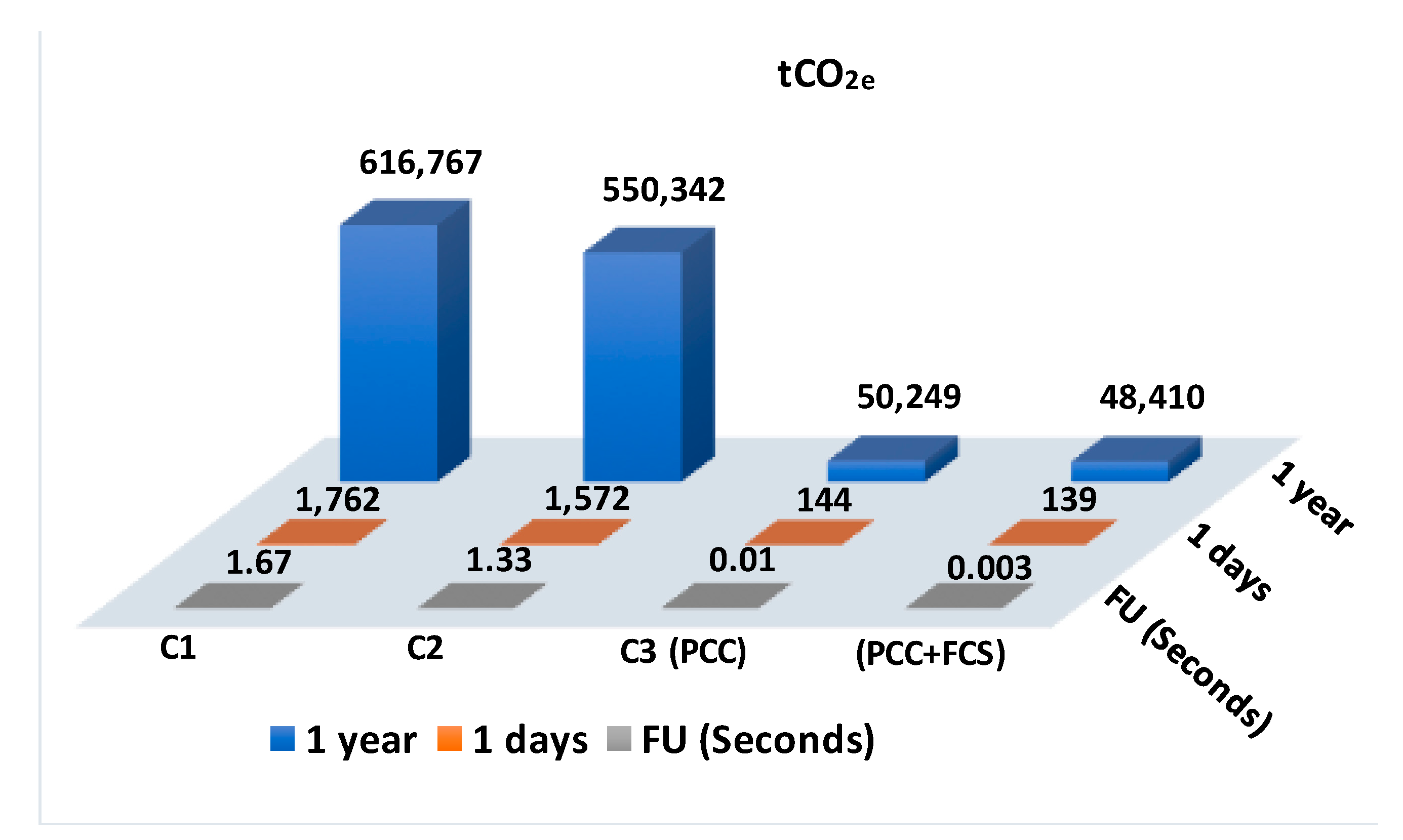
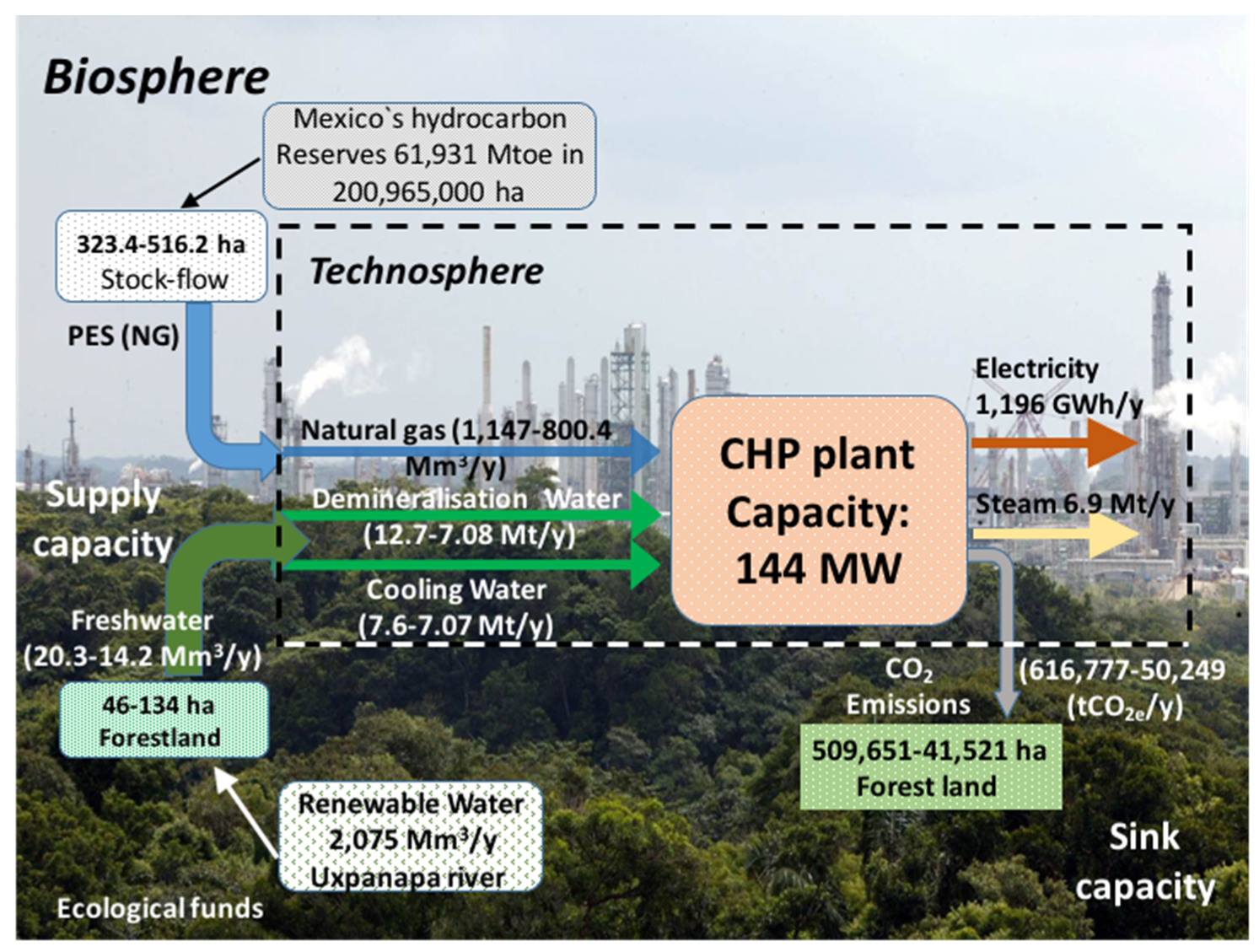
| Inflow Fund (Supply SIDE) | Outflow Fund (Sink SIDE) |
|---|---|
| Natural gas (PES) [m3/y] | Electricity (E) [GWh/y] |
| Water [m3/y] | CO2e [t/y] |
| O&G reserves [Mtoe] | Forest land [ha] |
| Land of oil and gas reserves [ha] |
| Watershed | Surface [ha] | Surface Water Availability [m3/yr] | Groundwater Availability [m3/yr] | Renewable Water [m3/yr] | Water Yield [m3/ha·yr] |
|---|---|---|---|---|---|
| Lower Uxpanapa River | 193,830 | 1,913,000,000 | 162,500,000 | 2,075,497,000 | 10,709 |
| Total water allocations in the basin: 49 Mm3/yr | |||||
| Type of Forest in Tuzandepetl (Tz) Park | Forest Land (ha) | Area Biomass (tC/ha) | Capture (tCO2/ha/yr) Average 60 Years | Capture by Coverage (tCO2/yr) | Average by Park (tCO2/ha/yr) | Total Capture (tCO2/yr) |
|---|---|---|---|---|---|---|
| Secondary tree vegetation | 297.5 | 72.3 | 2.0 | 599.8 | ||
| Secondary shrub vegetation | 62.0 | 4.6 | 0.9 | 53.6 | ||
| Mangrove | 55.4 | 74.0 | 4.6 | 255.4 | ||
| Grassland | 304.2 | 2.2 | 0.2 | 60.6 | 1.9 | 969.4 |
| Total | 719.0 | 969.4 | ||||
| Jaguaroundi (Ja) Park | ||||||
| Secondary tree vegetation | 166.0 | 106.0 | 2.4 | 401.8 | ||
| Secondary shrub vegetation | 113.0 | 27.0 | 0.8 | 90.6 | ||
| High evergreen lowland forest | 139.0 | 158.0 | 1.7 | 232.2 | ||
| Grassland | 383.0 | 1.5 | 0.4 | 145.4 | 1.3 | 870.0 |
| Total | 801.0 | 870.0 | 1839.4 |
| (a) FU Model (Time Scale: Seconds) | |||||
| Identifications | Unit | C1 | C2 | C3 | |
| Supply-side | External requirement inputs (LCI) (Biosphere) | ||||
| Water | Water | m3 | 20.5 | 8.73 | 8.73 |
| Energy (PES) | Natural gas | Nm3 | 1165.0 | 669.7 | 669.7 |
| Internal requirement inputs (LCI) (Technosphere) | |||||
| Caustic soda (50%) | kg | 6.3 | 0.01 | 0.01 | |
| Sulphuric acid (98%) | kg | 5.6 | 0.01 | 0.01 | |
| Aluminium sulphate | kg | 0.7 | 0.001 | 0.001 | |
| Materials | Chlorine | kg | 0.69 | 0.0007 | 0.001 |
| Chemical lime | kg | 0 | 0.00 | 0.00012 | |
| Condensed of comeback | t | 0 | 3.1 | 0 | |
| MEA make-up (30%) | t | 0 | 0 | 0.0 | |
| Energy | Consumption electricity | kWh | 0 | 0 | 75.2 |
| Water | Cooling water make-up | m3 | 7.7 | 2.8 | 2.8 |
| Demineralization water | m3 | 12.8 | 5.9 | 5.9 | |
| Outputs: products/emission (User: petrochemical plants) | |||||
| Energy (EC) | Electricity | MWh | 1.0 | 1.0 | 1.0 |
| Steam (45 kg/cm2) | t | 12.8 | 5.8 | 5.8 | |
| Steam (19 kg/cm2) | t | 0.20 | 0.16 | 0.16 | |
| Steam (4.5 kg/cm2) | t | 0 | 0.58 | 0 | |
| Emissions | Flue gas (CO2) | t | 1.67 | 1.33 | 0.01 |
| CO2 (As product by CO2 capture) | t | 0 | 0 | 0.06 | |
| Outputs: modelling environmental load (LCIA) | |||||
| Total Environmental Load | Climate change | kgCO2 eq | 626.0 | 460.0 | 42.0 |
| Ozone depletion | kg CFC-11 eq | 4 × 10−7 | 1 × 10−7 | 0 | |
| Human toxicity | kg 1,4-DB eq | 0.7 | 0.3 | 37.9 | |
| Photochemical oxidant formation | kg NMVOC | 3.0 | 1.9 | 0.3 | |
| Particulate matter formation | kg PM10 eq | 1.3 | 0.8 | 0.4 | |
| Ionising radiation | kg U235 eq | 0.3 | 0.0 | 0.5 | |
| Terrestrial acidification | kg SO2 eq | 5.6 | 3.6 | 1.8 | |
| Freshwater eutrophication | kg P eq | 6 × 10−5 | 6 × 10−6 | 0.1 | |
| Marine eutrophication | kg N eq | 0.1 | 0.0 | 0.0 | |
| Terrestrial ecotoxicity | kg 1,4-DB eq | 0.0 | 0.0 | 0.0 | |
| Freshwater ecotoxicity | kg 1,4-DB eq | 0.1 | 0.0 | 2.7 | |
| Marine ecotoxicity | kg 1,4-DB eq | 0.1 | 0.0 | 0.8 | |
| Agricultural land occupation | m2a | 0.001 | 0 | 0 | |
| Urban land occupation | m2a | 0.003 | 0 | 0.1 | |
| Natural land transformation | m2 | 0.000 | 0 | 0 | |
| Water depletion | m3 | 1.1 | 0.4 | 1.2 | |
| Metal depletion | kg Fe eq | 0.1 | 0.0 | 0.7 | |
| Fossil depletion | kg oil eq | 161.4 | 104.4 | 83.3 | |
| Sink-side | (Environmental load to local territory or region) | ||||
| (b) Scaled Process (One Year) | |||||
| Identifications | Unit | C1 | C2 | C3 | |
| Supply-side | External requirement inputs (LCI) (Biosphere) | ||||
| Water | Water | Mm3 | 20.3 | 14.2 | 14.2 |
| Energy (PES) | Natural gas | MNm3 | 1148.0 | 801.6 | 800.4 |
| Internal requirement inputs (LCI) (Technosphere) | |||||
| Caustic soda (50%) | t | 6207.1 | 7.42 | 7.4 | |
| Sulphuric acid (98%) | t | 39,842.9 | 38.88 | 38.9 | |
| Aluminium sulphate | t | 1086.8 | 0.951 | 1.0 | |
| Materials | Chlorine | t | 0.0 | 0 | 0.3 |
| Chemical lime | t | 126,259.8 | 96.19 | 0 | |
| Condensed of comeback | Mt | 0 | 3.7 | 0 | |
| MEA make-up (30%) | t | 0 | 0 | 3544 | |
| Energy | Consumption electricity | MWh | 0 | 0 | 7578 |
| Water | Cooling water make-up | Mm3 | 7.6 | 7.1 | 7.1 |
| Demineralization water | Mm3 | 12.7 | 7.1 | 7.1 | |
| Outputs: products/emission (User: petrochemical plants) | |||||
| Energy (EC) | Electricity | GWh | 985.3 | 1196.4 | 1196 |
| Steam (45 kg/cm2) | Mt | 7.1 | 6.9 | 6.9 | |
| Steam (19 kg/cm2) | Mt | 0.19 | 0.19 | 0.19 | |
| Steam (4.5 kg/cm2) | Mt | 0 | 0.6937 | 0 | |
| Emissions | Flue gas (CO2) | Mt | 1.65 | 1.50 | 0.02 |
| CO2 (As product by CO2 capture) | Mt | 0 | 0 | 376,250 | |
| Outputs: modelling environmental load (LCIA) | |||||
| Total Environmental Load | Climate change | t CO2 eq | 616,767 | 550,342 | 50,249 |
| Ozone depletion | t CFC-11 eq | 3.9 × 10−4 | 1.53 × 10−4 | 0 | |
| Human toxicity | t 1,4-DB eq | 661.9 | 364,856.9 | 45,343.4 | |
| Photochemical oxidant formation | t NMVOC | 2918.9 | 2293.2 | 299.1 | |
| Particulate matter formation | t PM10 eq | 1235.0 | 969.4 | 478.6 | |
| Ionising radiation | t U235 eq | 255.8 | 0.0 | 598.2 | |
| Terrestrial acidification | t SO2 eq | 5501.6 | 4320.1 | 2153.5 | |
| Freshwater eutrophication | t P eq | 0.1 | 0.0 | 59.8 | |
| Marine eutrophication | t N eq | 50.6 | 38.6 | 35.9 | |
| Terrestrial ecotoxicity | t 1,4-DB eq | 0.6 | 13.0 | 47.9 | |
| Freshwater ecotoxicity | t 1,4-DB eq | 85.2 | 4.2 | 3230.3 | |
| Marine ecotoxicity | t 1,4-DB eq | 83.7 | 4.0 | 957.1 | |
| Agricultural land occupation | m2a | 0.0 | 0.0 | 0.0 | |
| Urban land occupation | m2a | 0.0 | 0.0 | 0.1 | |
| Natural land transformation | m2 | 0.0 | 0.0 | 0.0 | |
| Water depletion | m3 | 1,065,826 | 496,352 | 1,435,674 | |
| Metal depletion | t Fe eq | 51.1 | 0.0 | 837.5 | |
| Fossil depletion | t oil eq | 159,068 | 124,852 | 99,660 | |
| Sink-side | (Environmental load to local territory or region) | ||||
| Water Depletion [m3/y] | Water Depletion/Water Yield Ratio (Hectares) | ||||||
|---|---|---|---|---|---|---|---|
| Unit | C1 | C2 | C3 | Unit | C1 | C2 | C3 |
| FU | 1.082 | 0.415 | 1.2 | - | - | - | - |
| 1 year | 1,065,826 | 496,352 | 1,435,674 | 1 year | 95.5 | 46.4 | 134.1 |
| Total Hydrocarbon Reserves b (Mtoileq) | NG Reserves (m3 × 109) | ||||
|---|---|---|---|---|---|
| 1P d (90%) | 2P d (50%) | 3P d (10%) | 1P d (90%) | 2P d (50%) | 3P d (10%) |
| 61,931 | 117,982 | 185,907 | 353,898 | 684,248 | 1,060,042 |
| Total reserve [PJ] | NG reserve [PJ] | ||||
| 98,944 | 722,292 | 98,944 | 722,292 | 98,944 | 722,292 |
| Reserve-oil extraction (R/E) ratio d (Years) e | Reserve gas extraction (years) | ||||
| 8.5 | 16.1 | 8.5 | 16.1 | 8.5 | 16.1 |
| Fund–flow ratio (Ha reserve) to CHP plant (fossil fuel depletion category) | |||||
| C1 | C2 | C3 | |||
| 516.2 | 405.1 | 323.4 | |||
| Scenario (Mitigation) | C1 (Baseline) | C2 | C3 | C1 (Baseline) | C2 | C3 |
|---|---|---|---|---|---|---|
| Forest Land [ha] | Num. of Parks (Tz-Ja) as Conservation Areas | |||||
| 10% | 509,65 | 45,476 | 4152 | 27.7 | 24.7 | 2.3 |
| 30% | 152,895 | 136,428 | 12,456 | 83.1 | 74.2 | 6.8 |
| 50% | 254,825 | 227,381 | 20,760 | 138.5 | 123.6 | 11.3 |
| 100% | 509,651 | 454,762 | 41,522 | 277.1 | 247.2 | 22.6 |
| CO2e emissions [t] | 616,766 | 550,342 | 50,249 | |||
| Fund–Flow and Flow–Fund Ratios | Unit | C1 | C2 | C3 |
|---|---|---|---|---|
| Forest land req | ha | 509,651 | 454,762 | 41,522 |
| CO2e | t | 616,766 | 550,342 | 50,249 |
| Ratio ha-t | 0.83 | 0.83 | 0.83 | |
| Electricity (EC) | MW | 985,250 | 1,196,395 | 1,196,395 |
| Ratio MW-ha | 1.9 | 2.6 | 29 | |
| kgCO2e/MWh [3] | 626 | 460 | 42 |
| Flow Requirement | Fund Size | Unit | C1 | C2 | C3 |
|---|---|---|---|---|---|
| Water depletion | m3 | 1,065,826 | 496,352 | 1,435,674 | |
| Forest land | ha | 99.5 | 46.4 | 134.1 | |
| Fossil depletion a | t oileq | 159,068 | 124,852 | 99,660 | |
| Stock land | ha | 516 | 405 | 323 | |
| Climate change | tCO2eq/y | 616,766 | 550,342 | 50,249 | |
| Forest land | ha | 509,651 | 454,762.4 | 41,522 | |
| Electricity | MWh | 985,250 | 1,196,395 | 1,196,395 | |
| Forest land | MW/ha | 1.9 | 2.6 | 29 |
© 2020 by the authors. Licensee MDPI, Basel, Switzerland. This article is an open access article distributed under the terms and conditions of the Creative Commons Attribution (CC BY) license (http://creativecommons.org/licenses/by/4.0/).
Share and Cite
Morales Mora, M.A.; Martínez Bravo, R.D.; Farell Baril, C.; Fuentes Hernández, M.; Martínez Delgadillo, S.A. An Integrated Approach to Determining the Capacity of Ecosystems to Supply Ecosystem Services into Life Cycle Assessment for a Carbon Capture System. Appl. Sci. 2020, 10, 622. https://doi.org/10.3390/app10020622
Morales Mora MA, Martínez Bravo RD, Farell Baril C, Fuentes Hernández M, Martínez Delgadillo SA. An Integrated Approach to Determining the Capacity of Ecosystems to Supply Ecosystem Services into Life Cycle Assessment for a Carbon Capture System. Applied Sciences. 2020; 10(2):622. https://doi.org/10.3390/app10020622
Chicago/Turabian StyleMorales Mora, Miguel A., Rene D. Martínez Bravo, Carole Farell Baril, Mónica Fuentes Hernández, and Sergio A. Martínez Delgadillo. 2020. "An Integrated Approach to Determining the Capacity of Ecosystems to Supply Ecosystem Services into Life Cycle Assessment for a Carbon Capture System" Applied Sciences 10, no. 2: 622. https://doi.org/10.3390/app10020622
APA StyleMorales Mora, M. A., Martínez Bravo, R. D., Farell Baril, C., Fuentes Hernández, M., & Martínez Delgadillo, S. A. (2020). An Integrated Approach to Determining the Capacity of Ecosystems to Supply Ecosystem Services into Life Cycle Assessment for a Carbon Capture System. Applied Sciences, 10(2), 622. https://doi.org/10.3390/app10020622





